

Publications ← P2P Lab. Ervin Laszlo. Available on Innertraditions.

WorldShift 2012Making Green Business, New Politics, and Higher Consciousness Work Together By (author) Ervin LaszloForeword by Deepak ChopraForeword by Mikhail Gorbachev A handbook for conscious change that could transform the current world crisis into planetary renewal • Outlines the problems that make today’s world prone to breakdown and suggests actions we must adopt in politics, business, and everyday life • Replaces the limited consciousness of our failing society with the holistic consciousness that is rooted in the Akashic field.
Google+ Alvin + heidi toffler {futurists} Démocratie, Crise ou Synergie. Celtic Tattoos Tree Of Life Meaning 06.jpg (JPEG Image, 427 × 350 pixels) Collective Behavior and Social Movements. Occupy Central 2.0. Benny Tai is an academic.
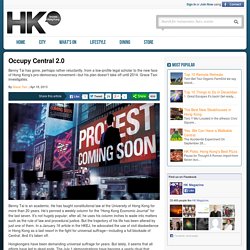
He has taught constitutional law at the University of Hong Kong for more than 20 years. He’s penned a weekly column for the “Hong Kong Economic Journal” for the last seven. It’s not hugely popular; after all, he uses his column inches to wade into matters such as the rule of law and procedural justice. For Whom the Whistle blows? Secrecy, Civil Disobedience, and Democratic Accountability. PhD Dissertation in Political Theory XXVI Cycle PhD Candidate: Manohar Kumar Page 3 Acknowledgements Embarking on an intellectual enterprise is often a journey which involves delving deep into problems which at the outset seems to resist conclusions.

You often begin in wonder, but as you go deep into the problem, uncover layers and layers of its hidden meanings, you understand it better, if not answer it. Alone. Debts. Alexander von Humboldt Institut für Internet und Gesellschaft. Until today the case of Aaron Swartz leaves the ones who knew him – and many others who admire him – in despair.

He was threatened with 35 years of imprisonment and a one million dollar fine for the unlawful download of 4 million research articles. His suicide is a wake-up call: Is it really people like Aaron who deserve to be punished as trouble-makers for our societies? Or is it rather the case »that the world is topsy-turvy, that things are all wrong, that the wrong people are in jail and the wrong people are out of jail, that the wrong people are in power and the wrong people are out of power?” (Zinn 1972). Civil disobedience is a principle-based political strategy that aims to influence laws or political measures by intentionally breaking the law. In this article I argue that a variety of new forms of civil disobedience challenge the traditional understanding and require us to re-think the concept for the digital age.
On another level, we can see a semiotic change. Photo: zeevveez. Aldiko™ - eBook Reader Application for Android. (Official Movie) THRIVE: What On Earth Will It Take? Film review: Why ‘Thrive’ is best avoided. 9 Jan 2012.
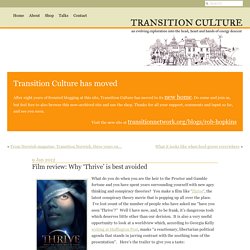
Film review: Why ‘Thrive’ is best avoided. Building Community and Collaboration Applications for MMOGs. The World's Most Innovative Bank Taps P2P, Crowdsourcing, Social Media [VIDEO] A few days ago, Fidor Bank AG‘s released this short Fidor Bank video where they talk you through their concept and most of the digital banking innovations they introduced over the last few years.
![The World's Most Innovative Bank Taps P2P, Crowdsourcing, Social Media [VIDEO]](http://cdn.pearltrees.com/s/pic/th/crowdsourcing-visiblebanking-55173729)
Imagine the blueprint for the bank of the future, except that it is live and available in Germany and now Russia. Matthias Kroener – Fidor’s Founder & CEO (@ficoba) is one of the most passionate banking CEOs I know on the topics of digital innovation, social media and customer advocacy. Fidor’s online platform is extremely innovative and includes virtual currencies trading, P2P advices, social media banking, facebook and twitter payments. PeerSoN - Peer-to-Peer Social Networking. Distributed Social Network Projects.
URL = These are projects that are designed to run on servers and use federation protocols to reach out and interchange between each other. 6d, Ampify, Appleseed, buddycloud,
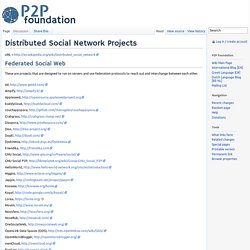
The Wisdom of Crowds. The Wisdom of Crowds: Why the Many Are Smarter Than the Few and How Collective Wisdom Shapes Business, Economies, Societies and Nations, published in 2004, is a book written by James Surowiecki about the aggregation of information in groups, resulting in decisions that, he argues, are often better than could have been made by any single member of the group.
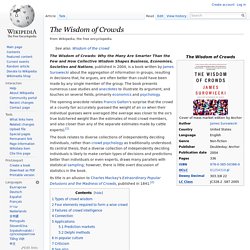
The book presents numerous case studies and anecdotes to illustrate its argument, and touches on several fields, primarily economics and psychology. The opening anecdote relates Francis Galton's surprise that the crowd at a county fair accurately guessed the weight of an ox when their individual guesses were averaged (the average was closer to the ox's true butchered weight than the estimates of most crowd members, and also closer than any of the separate estimates made by cattle experts).[1] Types of crowd wisdom[edit] Surowiecki breaks down the advantages he sees in disorganized decisions into three main types, which he classifies as.
Collective intelligence. Types of collective intelligence Collective intelligence is shared or group intelligence that emerges from the collaboration, collective efforts, and competition of many individuals and appears in consensus decision making.
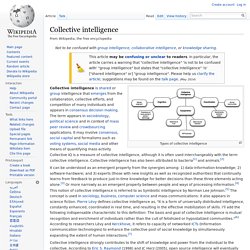
The term appears in sociobiology, political science and in context of mass peer review and crowdsourcing applications. The Power of Collective Thought. Collective intelligence. Social Collective Intelligence - Combining the Powers of Humans and Machines to Build a Smarter. Features a holistic multidisciplinary perspective on social collective intelligence, including foundational approaches, enabling technologies, and applications/case studies Contains a taxonomy of research challenges to be tackled within various disciplines (computer science and social sciences) Includes a number of chapters related to specific applications from experts in the field and description of concrete and tangible case studies Aims at becoming the reference handbook for researchers and practitioners in the emerging field of social collective intelligence Content Level » Research Keywords » Collective Adaptive Systems - Collective Intelligence - Human Computer Interfaces - Hybrid Social Computational Systems - Programming Social Collectives - Social Collective Intelligence Systems - Social Computing - Social Networks - Socio-technical Systems - Technology-society Co-design Related subjects » Applications - Complexity - HCI Table of contents Popular Content within this publication.
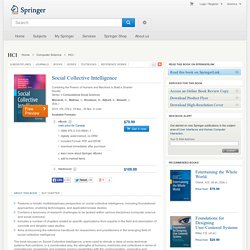
Networked Capitalism: A World of Cyber-Cells. The impact social media has had on our daily lives – we now record where we go, what we do and what we think for the world to see – has radically changed the way we relate to ourselves and each other. #Global Spring: Towards an advanced and mature world civilisation. Our current civilization is based on the dominancy of capitalist mode of production relations and other social relations that are in large portion outcomes of or strongly determined by the principal relationships of this mode, including ‘foreign’ relations between alienated human societies. The rising people’s grassroots movement openly and clearly challenges and wants to change these relationships at a global scale. This conscious ‘demand’ of the peoples is being unsuccessfully undermined by the mainstream media.
The existence of astonishing number of alternative visions for the aftermath of the approaching collapse is the proof of this: the gift economy, solidarity economy, participatory economy, resource based economy, commons based economy, and many more. The material basis that gives way to such visions to be born is the actual changes have taken place in productive forces since the 70s. Since then ‘networks’ OCCUPY THE SPACE both in reality and in our daily languages.
#Global Spring: Towards an advanced and mature world civilisation. Aldiko™ - eBook Reader Application for Android. Social Movements and Collective Action. To date (for a review, Crossley, 2007), withexamples ranging from local communities inRomania (Vasi, 2004) and Mexico (Holzner,2004) to university students’ networks in theUnited Kingdom (Crossley, 2008), from peace(Nepstad, 2004) and civil rights activism (Lowe,2007) to white power groups (Futrell and Simi,2004). Most important, however, is the fact thatover the years, questions such as “Whichnetworks do explain what?” And “Under whatconditions do specific networks become rele-vant?” Have been constantly refined. Some havefound previous activism to increase centrality ininterpersonal networks, which in turn facilitatedinvolvement in subsequent campaigns (e.g. Aldiko™ - eBook Reader Application for Android. Tetris effect. Screenshot of a tetromino game. People who play video puzzle games like this for a long time may see moving images like this at the edges of their visual fields, when they close their eyes, or when they are drifting off to sleep.
The Tetris effect (also known as Tetris Syndrome) occurs when people devote so much time and attention to an activity that it begins to pattern their thoughts, mental images, and dreams. It is named after the video game Tetris. Other examples[edit] The Tetris effect can occur with other video games.[2] It has also been known to occur with non-video games, such as the illusion of curved lines after doing a jigsaw puzzle, or the involuntary mental visualisation of Rubik's Cube algorithms common amongst speedcubers.
On a perceptual level, sea legs are a kind of Tetris effect. ’Tain’t—so—bad—by—day because o’ company,But—night—brings—long—strings—o’ forty thousand million Boots—boots—boots—boots—movin’ up an’ down again. Place in cognition[edit] L'effet Tetris[edit] Video Games - I have a dream - Video Game Memes - video game memes. A Toolbox for Building P2P-based Social Networks. Creative Commons. Ciberciudadanos_Netizens. Aldiko™ - eBook Reader Application for Android. Creative Commons.